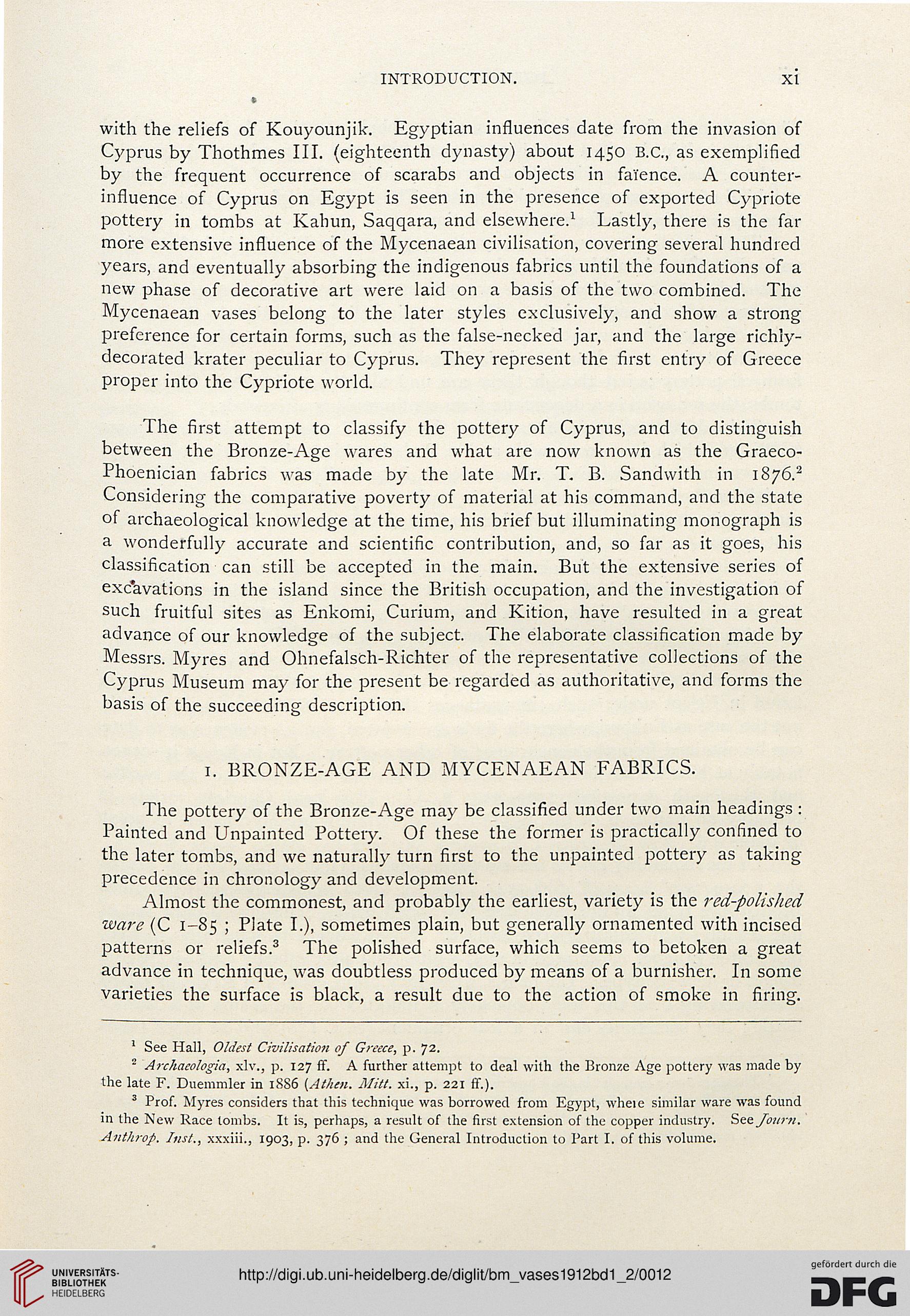INTRODUCTION. XI
with the reliefs of Kouyounjik. Egyptian influences date from the invasion of
Cyprus by Thothmes III. (eighteenth dynasty) about 1450 B.C., as exemplified
by the frequent occurrence of scarabs and objects in faience. A counter-
influence of Cyprus on Egypt is seen in the presence of exported Cypriote
pottery in tombs at Kahun, Saqqara, and elsewhere.1 Lastly, there is the far
more extensive influence of the Mycenaean civilisation, covering several hundred
years, and eventually absorbing the indigenous fabrics until the foundations of a
new phase of decorative art were laid on a basis of the two combined. The
Mycenaean vases belong to the later styles exclusively, and show a strong
preference for certain forms, such as the false-necked jar, and the large richly-
decorated krater peculiar to Cyprus. They represent the first entry of Greece
proper into the Cypriote world.
The first attempt to classify the pottery of Cyprus, and to distinguish
between the Bronze-Age wares and what are now known as the Graeco-
Phoenician fabrics was made by the late Mr. T. B. Sandwith in 1876.2
Considering the comparative poverty of material at his command, and the state
of archaeological knowledge at the time, his brief but illuminating monograph is
a wonderfully accurate and scientific contribution, and, so far as it goes, his
classification can still be accepted in the main. But the extensive series of
exe'avations in the island since the British occupation, and the investigation of
such fruitful sites as Enkomi, Curium, and Kition, have resulted in a great
advance of our knowledge of the subject. The elaborate classification made by
Messrs. Myres and Ohnefalsch-Richter of the representative collections of the
Cyprus Museum may for the present be regarded as authoritative, and forms the
basis of the succeeding description.
1. BRONZE-AGE AND MYCENAEAN FABRICS.
The pottery of the Bronze-Age may be classified under two main headings :
Painted and Unpaintcd Pottery. Of these the former is practically confined to
the later tombs, and we naturally turn first to the unpainted pottery as taking
precedence in chronology and development.
Almost the commonest, and probably the earliest, variety is the red-polished
ware (C 1-85 ; Plate I.), sometimes plain, but generally ornamented with incised
patterns or reliefs.3 The polished surface, which seems to betoken a great
advance in technique, was doubtless produced by means of a burnisher. In some
varieties the surface is black, a result due to the action of smoke in firing.
1 See Hall, Oldest Civilisation of Greece, p. 72.
2 Archaeologia, xlw, p. 127 ff. A further attempt to deal with the Bronze Age pottery was made by
the late F. Duemmler in 1886 (At/ien. Mitt, xi., p. 221 ff.).
3 Prof. Myres considers that this technique was borrowed from Egypt, wheie similar ware was found
in the New Race tombs. It is, perhaps, a result of the first extension of the copper industry. Seejburn.
Anthrop, Inst., xxxiii., 1903, p. 376 ; and the General Introduction to Part I. of this volume.
with the reliefs of Kouyounjik. Egyptian influences date from the invasion of
Cyprus by Thothmes III. (eighteenth dynasty) about 1450 B.C., as exemplified
by the frequent occurrence of scarabs and objects in faience. A counter-
influence of Cyprus on Egypt is seen in the presence of exported Cypriote
pottery in tombs at Kahun, Saqqara, and elsewhere.1 Lastly, there is the far
more extensive influence of the Mycenaean civilisation, covering several hundred
years, and eventually absorbing the indigenous fabrics until the foundations of a
new phase of decorative art were laid on a basis of the two combined. The
Mycenaean vases belong to the later styles exclusively, and show a strong
preference for certain forms, such as the false-necked jar, and the large richly-
decorated krater peculiar to Cyprus. They represent the first entry of Greece
proper into the Cypriote world.
The first attempt to classify the pottery of Cyprus, and to distinguish
between the Bronze-Age wares and what are now known as the Graeco-
Phoenician fabrics was made by the late Mr. T. B. Sandwith in 1876.2
Considering the comparative poverty of material at his command, and the state
of archaeological knowledge at the time, his brief but illuminating monograph is
a wonderfully accurate and scientific contribution, and, so far as it goes, his
classification can still be accepted in the main. But the extensive series of
exe'avations in the island since the British occupation, and the investigation of
such fruitful sites as Enkomi, Curium, and Kition, have resulted in a great
advance of our knowledge of the subject. The elaborate classification made by
Messrs. Myres and Ohnefalsch-Richter of the representative collections of the
Cyprus Museum may for the present be regarded as authoritative, and forms the
basis of the succeeding description.
1. BRONZE-AGE AND MYCENAEAN FABRICS.
The pottery of the Bronze-Age may be classified under two main headings :
Painted and Unpaintcd Pottery. Of these the former is practically confined to
the later tombs, and we naturally turn first to the unpainted pottery as taking
precedence in chronology and development.
Almost the commonest, and probably the earliest, variety is the red-polished
ware (C 1-85 ; Plate I.), sometimes plain, but generally ornamented with incised
patterns or reliefs.3 The polished surface, which seems to betoken a great
advance in technique, was doubtless produced by means of a burnisher. In some
varieties the surface is black, a result due to the action of smoke in firing.
1 See Hall, Oldest Civilisation of Greece, p. 72.
2 Archaeologia, xlw, p. 127 ff. A further attempt to deal with the Bronze Age pottery was made by
the late F. Duemmler in 1886 (At/ien. Mitt, xi., p. 221 ff.).
3 Prof. Myres considers that this technique was borrowed from Egypt, wheie similar ware was found
in the New Race tombs. It is, perhaps, a result of the first extension of the copper industry. Seejburn.
Anthrop, Inst., xxxiii., 1903, p. 376 ; and the General Introduction to Part I. of this volume.




